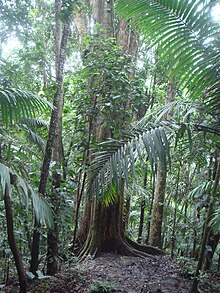Balatá
| Manilkara bidentata | |
|---|---|
 |
|
| Scientific classification | |
| Kingdom: | Plantae |
| (unranked): | Angiosperms |
| (unranked): | Eudicots |
| (unranked): | Asterids |
| Order: | Ericales |
| Family: | Sapotaceae |
| Genus: | Manilkara |
| Species: | M. bidentata |
| Binomial name | |
|
Manilkara bidentata (A.DC.) A.Chev. |
|
| Synonyms | |
|
Mimusops bidentata A.DC.
|
|
Mimusops bidentata A.DC.
Mimusops globosa C.F.Gaertn.
Mimusops balata Crueg. ex Griseb.
Manilkara bidentata is a species of Manilkara native to a large area of northern South America, Central America and the Caribbean. Common names include bulletwood,balatá, ausubo, massaranduba, and (ambiguously) "".
Balatá is a large tree, growing to 30–45 m (98–148 ft) tall. The leaves are alternate, elliptical, entire, and 10–20 cm (3.9–7.9 in) long. The flowers are white, and are produced at the beginning of the rainy season. The fruit is a yellow berry, 3–5 cm (1.2–2.0 in) in diameter, which is edible; it contains one (occasionally two) seed(s). Its latex is used industrially for products such as chicle.
The latex is extracted in the same manner in which sap is extracted from the rubber tree. It is then dried to form an inelastic rubber-like material. It is almost identical to gutta-percha (produced from a closely related southeast Asian tree), and is sometimes called gutta-balatá.
Balatá was often used in the production of high-quality golf balls, to use as the outer layer of the ball. Balatá-covered balls have a high spin rate, but do not travel as far as most balls with a Surlyn cover. Due to the nondurable nature of the material the golf club strikes, balatá-covered balls do not last long before needing to be replaced. While once favored by professional and low-handicap players, they are now obsolete, replaced by newer Surlyn and urethane technology.
...
Wikipedia
